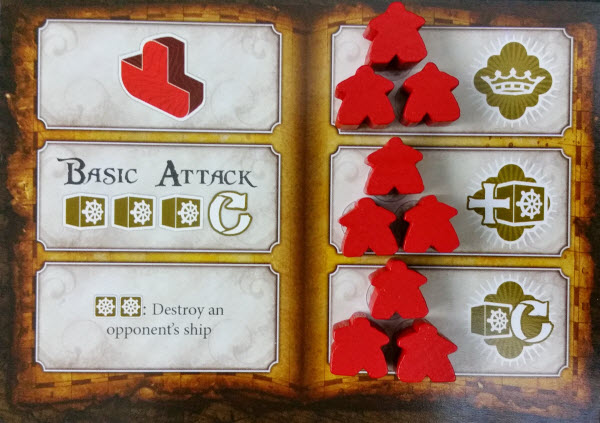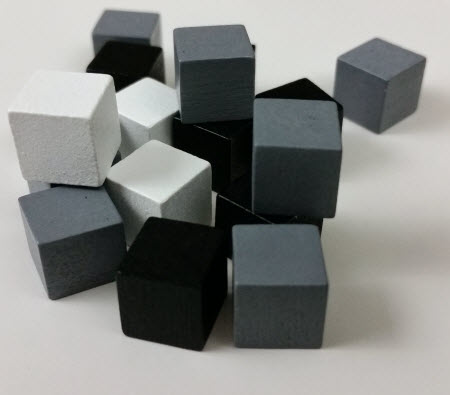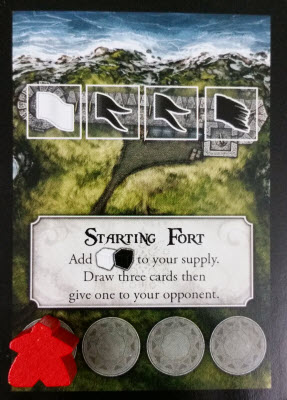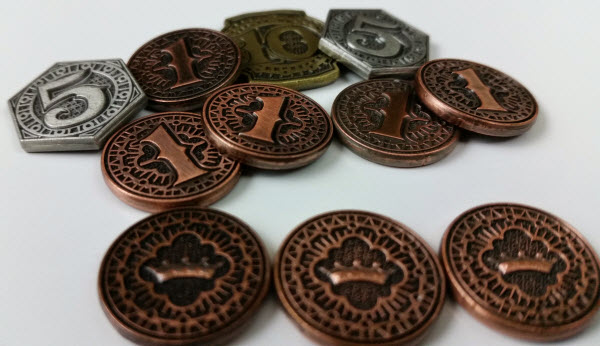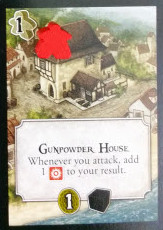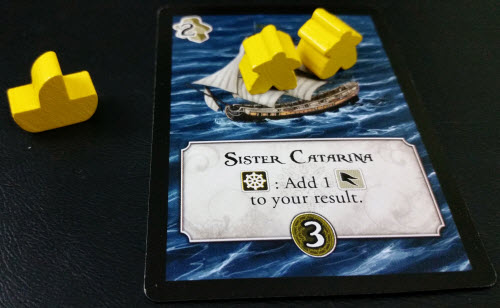“Tell me Midshipman Caulfield, what do you see?” Captain Prescott walked to the edge of the ship, his frock coat flapping absently.
“It’s hard to make out the mizzenmasts at this angle, sir, but the galley is unmistakable.” Peter Caulfield lowered the spyglass. “I have no doubt that is the galleon Jugador. She bears the scars from when we gave chase three days ago.”
“One day too late, it would seem.” Prescott paused, tapping on the railing before rounding back on his officer. “We make hard for San Dados. If the winds favor us, we may reach it before them.
“Aye captain,” Caulfield replied, relaying the orders down onto the deck. Men below scurried into a dance-like routine. “Though if they reach Dados first…”
“If they reach it first, Peter, we obliterate the walls they seek refuge behind and finish what we started…”
The Premise
Colonial European powers weren’t known to get along, especially when fighting over the same territories. That conflict is at the heart of Island Siege. In it, two players hash out imperial ambitions as each side puts their naval acumen to use building forts and ships to protect their colonies, all while chipping away at their opponent’s defenses.
The Rules
In this compact two player card and dice game of cannon fire and fodder, both sides seek to end to their opponent’s reign. As such, Island Siege is comprised mainly of a card deck and building resources made up of black, gray, and white cubes.
At the beginning of the game, each player receives an Imperial Card housing nine Colonists. As players remove Colonists to serve in Forts and Buildings, they earn bonus dice effects. Additionally, players start with an initial Fort with four cubes, along with an additional black and white cube for their supply.
Finally, each player draws three cards, keeping two and passing the third to their opponent. The first player is determined randomly.
Every turn in Island Siege consist of three phases: Victory, Colonize, and Action, excepting that the first turn begins with Action.
The first phase is merely a victory check to determine if a player has won. In Colonize, players move a Colonist from their Imperial Card onto each Fort they control with an open space.
The majority of Island Siege, though, centers on the Action phase. Here, the player takes one of five actions:
-
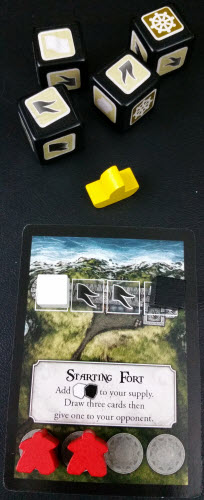
Yellow uses their White die result to remove one cube from Red’s fort, then collects 2 Gray dice as reinforcements. The Fort stands with 1 Black cube.
Draw: The player draws three cards, picks two, and gives the third to their opponent.
- Build a Fort: Play a Fort, adding resource cubes to it for each colored flag icon. Players may place additional cubes from their personal supply onto extra new Fort slots. For each cube placed this way, the player gains one coin.
- Build a Building: Place a Building below a Fort that contains the Building’s required number of Colonists and move those Colonists onto the Building. Beyond providing abilities, constructing a Building provides coin and one or more free resource cubes to add to the Fort, if possible.
- Build a Ship: Play a Ship. Like Buildings, Ships provide abilities and must be supported by Colonists. The player moves the stated number of Colonists from a single Fort onto the Ship, gaining coins.
- Attack An Opposing Fort: The player selects an enemy Fort and rolls three dice (plus a reroll). Aside from Leadership results used for special actions, the player chooses one resource color from the results. So long as the total is greater or equal to a row of colored cubes in the Fort, remove one cube for each dice result.Then, the attacker either collects a resource cube of each remaining dice result or removes additional cubes from the Fort with Target results. When a Fort has zero cubes, it and any attached Buildings are destroyed; all Colonists on them are returned to the player’s Imperial card.
Once finished, the other player takes their turn. Turns alternate until a player either has amassed 20 coins or has all nine Colonists in play during their Victory phase. By royal decree, that player is appointed Governor and shall live life in style, fame, and comfort.
The other player is probably going to be fitted for a nice pair of ankle shackles.
Unliving Color
Traditionally, battlement fortifications have been full of drab utilitarianism and spartan purpose. By their nature, forts existed as important defensive structures; their walls, turrets, and personnel guarding whatever they were charged to protect. Regardless of their purpose though, military fortifications were never known for being decorative or flashy. In many cases, having them not stand out is sort of the idea. In that sense, it’s completely understandable why Island Siege chose the resource cube colors it did. Reflecting the colors of stone materials, black, gray, and white are quite fitting.
However, in a case of art imitating life, this color scheme proves problematic.
Individually there’s nothing wrong with any of the colors, but when combined with one another, as well as with the artwork on Fort cards, it’s often difficult to quickly differentiate the black and gray cubes from one another.
This difficulty is compounded by the corresponding flag colors on the cards and dice, which are also black and gray, look incredibly similar to each other unless you’re playing in a well-lit area. Even though the shape of the flags vary, it usually takes a moment to register which cube is which. The color-blurring isn’t a deal-breaker, but it does detract from the game’s worth, routinely double checking which color is being referenced becomes a small but unnecessary speed bump to Island Siege’s otherwise streamlined gameplay.
That said, although these cubes reflect the thematic nature of building materials in the game, don’t expect Immersionists to get overly excited about this one. Island Siege is set in a generic time and location during the European colonial era, and there’s little narrative for players to latch on to here.
Scattershot Cannonballs
Unfortunately, it’s not just the building cubes that illicit a mixed response: the comparative quality of Island Siege’s components are about as wide-ranging as a cannon’s firing arc.
On the low end are the game’s sticker dice. Ultimately, how you feel about sticker dice in general is largely a personal preference, but their presence is hard to ignore in this game. Dice rolling is how you attack your opponent and, by extension, how you accumulate more building cubes. It’s also one of the two ways to actually win. Thus, a lot of time is spent looking at die results throughout Island Siege. Between the aforementioned issues with flag colors and the light sticker backgrounds make it easier to notice dirt or wear, the dice diminish the game’s presentation. As such a central component, you would expect that they dress for the part. Sadly, they do not.
At the other end of the spectrum lies the game’s currency. Island Siege’s metal coins, while not numerous, are hands-down its best physical attribute. Each coin denomination is custom designed to fit the look and feel coins from that era of history, replete with engraved etchings and the nice tangible weight of actual coinage. As a currency tracker, they succeed marvelously. In fact, it’s a shame they’re only used to keep tabs on how much money you have. At the very least, they’re worth competing over, both in terms of the victory condition and the bragging rights over who has a nicer treasure stash.
Beware The City Of Gold
Despite the game’s various aesthetic misfires, Island Siege maintains all of the necessary buoyancy and firepower to make a decent half hour game.
It does this two ways. The first is how it handles card draw. With Island Siege, drawing cards is like playing chicken on the high seas. Spending your turn to draw always yields two cards, but your opponent also profits by gaining a single card for free. This creates an interesting and uncommon dynamic, wherein players scheme to go as long as they can before drawing, hoping the other player will blink first. Given that hand sizes are pretty low, the desire to draw is directly pitted against the desire to not let your enemy benefit, creating a small but reputable degree of game tension.
The second is how much Island Siege embraces being a skirmish game. Fights here are more a series of pitched battles than an intransigent war, and gameplay reflects the necessity to play as such. This is illustrated through few different methods.
For starters, there are the card limitations. Forts can be played freely, but if you don’t have the prerequisite Colonists for a Ship or Building, these cards sit idle in your hand until you can, forcing you to decide whether to drop another Fort, draw more cards, or go on the attack.
When pairing these limits with only having a single action on your turn, Island Siege removes the need to think very far ahead. Beyond gauging how to get a 3-cost Ship or Building out, Island Siege largely keeps your focus on the immediacy of your turn. This in-the-moment play style, along with its simple rule set, could help get Socializers on board, though the duelist nature may still give them pause. On the other hand, with the inability to have a larger picture, assume Tacticians to jump ship entirely in this showdown.
Secondly, Island Siege doesn’t reward you for centralizing your assets. The more Buildings a Fort has, the more of a target it becomes. While Buildings technically can be played for their coin payout alone, the time it takes to attain and construct one – along the benefits they provide – don’t make them that expendable.
As a result, the game encourages diversification across multiple fronts to lessen the impact when Forts inevitably falls to cannon fire. And fall they will. As such, Architects won’t be on deck for this fight. The constant threat of attack and ease at which a lucky roll or two can dismantle most Forts makes it particularly difficult to amass much solid territory; your holdings are transitory at best.
Then there’s the nature of attacking itself. Combat in Island Siege is largely at the whim of the dice, as aside from the possibility of a second set of rerolls, a fourth dice, or a Ship / Building bestowing an extra die effect, there is little you can do to manipulate the outcome. You could roll exactly what you need to decimate the Fort you’re attacking, or you may fail so spectacularly that you couldn’t hit the water if you were aiming for it. Even though they may feel hampered by its slightly linear gameplay, the unpredictability of combat in Island Siege will entice Daredevil looking to take their chances. In opposition to this are Strikers, who normally don’t like games where dice-laden results largely determine its outcome. Since that’s the case here, with only marginal mitigation, they won’t be enlisting anytime soon.
The Takeaway
For a dice game largely set on the water, Island Siege can also feels like it’s on rails. Turns are quick and decisive, and the simple ruleset makes it accessible and easy to learn – which is ideal for a light Filler Game. Yet the three basic decisions in Island Siege are largely at the whim of chance, its strategy distilled into either playing a card or attacking via unpredictable dice. The contents are similarly mixed, as on the one hand Island Siege certainly could benefit from customized dice and a better contrast of cube colors, while on the other it offers some truly impressive metal coins. Nevertheless, Island Siege proves a serviceable option for those who’d enjoy a light dice game with some simple choices, but for those seeking a heftier fight, it’s best to set sail for another port.
Island Siege is a product of APE Games.
Cardboard Republic Snapshot Scoring (Based on scale of 5):
Artwork: 3
Rules Clarity: 4.5
Replay Value: 3
Physical Quality: 3
Overall Score: 3
Photo Credits: Eggs by Homestead and Gardens.

